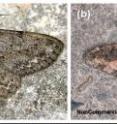Camouflage of moths: Secrets to invisibility revealed
Moths are iconic examples of camouflage. Their wing coloration and patterns are shaped by natural selection to match the patterns of natural substrates, such as a tree bark or leaves, on which the moths rest. But, according to recent findings, the match in the appearance was not all in their invisibility. Despite a long history of research on these iconic insects, whether moths behave in a way to increase their invisibility has not been determined. A research team from the Laboratory of Behavioral Ecology and Evolution at the Seoul National University has conducted an experiment to directly answer this question. Chang-ku Kang, Jong-yeol Moon, Sang-im Lee and Piotr Jablonski have found out that moths walk on the tree bark until they settle down to rest; the insects seem to actively search for a place and a body position that makes them practically invisible.
Instead of placing moth specimens on a tree bark in various positions to see how body orientation of moths make them invisible to birds, which has been done by several researchers, "we let the moths to do the job for us" says Changku Kang, the PhD student who conducted the experiment. The researchers let inchworm moths of two species (Jankowskia fuscaria and Hypomycis roboraria; Fig. 1) land on tree bark and freely choose the final resting spot and body orientation. Many moths did not remain at the spot of landing. They walked around with stretched wings as if they were looking for that one perfect spot that may make them invisible to predators.
To determine whether this final spot indeed made the moth really invisible, the researchers photographed each moth at its landing spot (initial spot) and at the final spot at which the moth decided to rest. Next, the researchers asked people to try to locate the moth from the photograph as quickly as possible. People had more difficulty finding the moths at their final spots than the same moths at their initial landing spots.
Amazingly, this was even true for the species (Hypomecis roboraria) that only changed its resting spot on the tree bark without changing its body orientation. Therefore, the researchers concluded, that moths seems to actively choose the spot that makes them invisible to predators. How do they know how to become invisible? The research team is now trying to answer this question as the next step.
Source: Laboratory of Behavioral Ecology and Evolution at Seoul National University
Other sources
- Camouflage of moths: Secrets to invisibility revealedfrom Physorg12 years ago


